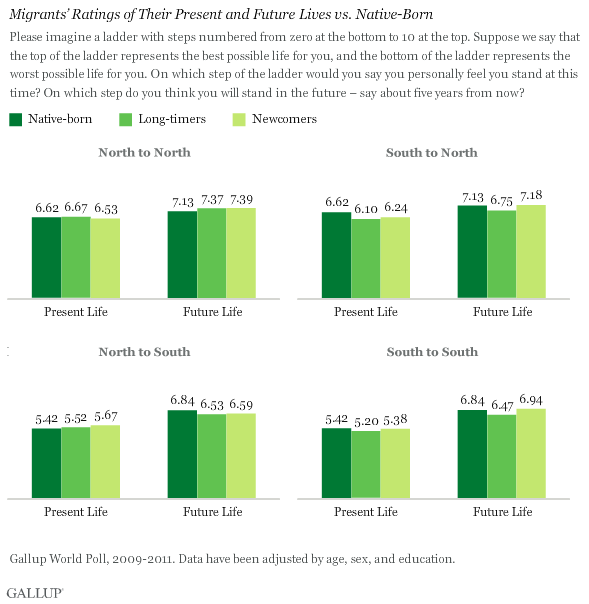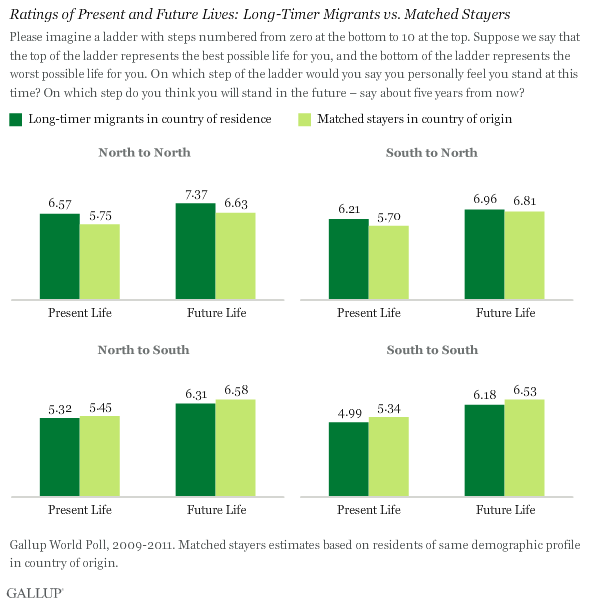WASHINGTON, D.C. -- Worldwide, where migrants come from, where they go, and how long they stay affects their well-being. Many migrants, for example, rate their lives worse than the native-born in their new countries, but the situations are different for migrants living in high-income economies (referred to as "the North") and middle- to low-income economies (referred to as "the South").

These findings, featured in the International Organization for Migration's World Migration Report 2013, are based on Gallup World Poll interviews with nearly 25,000 first-generation migrants and 442,000 native-born residents in 150 countries between 2009 and 2011. The large sample enables Gallup to divide migrants into two categories -- newcomers (who moved to their destination countries less than five years ago) and long-timers (who have been living in their current countries for at least five years) -- and compare their life experiences with the native-born.
Migrants who have moved from one high-income economy to another (North to North) are as upbeat about their present lives as the native-born in their destination countries, and even more optimistic about what their lives will be like in five years. Those moving from a middle- to low-income economy to a high-income one (South to North), however, rate their current lives significantly worse than the native-born do. While long-timers are the most pessimistic about their future lives, newcomers are as optimistic about their future lives as the native-born.
Migrants who move from one middle- to low-income economy to another (South to South) generally fare the worst. Long-timers who have moved from South to South feel worse about their current and future lives than those who have moved from the North. There is no difference between North-to-South migrants' and native-born residents' ratings of their present lives, but migrants are more pessimistic about their futures.
Some Migrants' Lives Better, Some Worse Than If They Had Stayed Home
Gallup's extensive database makes it possible to investigate what migrants have personally gained and lost by migrating. Using a statistical model that compares the lives of migrants with the lives of people with the same age, sex, and education profile in their countries of origin, it is possible to impute what migrants' lives hypothetically would have been like had they stayed home.
Long-timer North-to-North migrants' life evaluations, for example, are significantly more positive compared with those of similar people -- their matched stayers -- in their countries of origin. Long-timer South-to-North migrants, however, rate their current lives higher than their counterparts in their countries of origin, but they rate their futures the same.

Those moving from developing countries to other developing countries do not experience the same benefits from migration. South-to-South long-timers not only rate their lives worse than the native-born do, but they also rate their lives worse than if they had stayed home. This pessimistic pattern is evident in other aspects of their well-being.
Bottom Line
While the body of research on migration and well-being is growing, most studies up to this point have focused on migrant populations in specific countries or regions. For the first time, Gallup's ongoing World Poll surveys make it possible to assess the overall subjective well-being of migrants worldwide, as well as the career, financial, community, social, and physical elements of their well-being.
Migrants' life evaluations and other aspects of their well-being detailed in the World Migration Report 2013 reveal that migrants worldwide face different challenges, depending on the direction of their migration flow. Length of stay in a destination country also plays a big role in migrants' well-being. What might be vital to a newcomer who has lived in his or her adopted country for less than five years may be different from what a migrant who has lived there longer needs.
For complete data sets or custom research from the more than 150 countries Gallup continually surveys, please contact us.
Survey Methods
Results are based on Gallup World Poll data collected across 150 countries and areas in 2009, 2010, and 2011. The typical sample size was 1,000 adults (aged 15 and older) per country per year. Projection weighting was performed so that each country's data are proportional to the total world population. A total of 466,689 adults were included in the analysis, including 441,901 native-born residents and 24,788 first-generation migrants. Countries were classified as "North" (high-income economies) or "South" (middle- to low-income economies) according to World Bank categories. Migrants surveyed were born in 188 countries (51 of which were in the North and 137 were in the South) and lived in 150 destination countries (40 in the North, 110 in the South).
